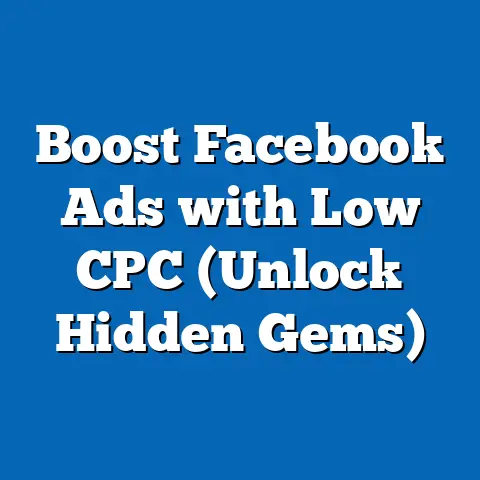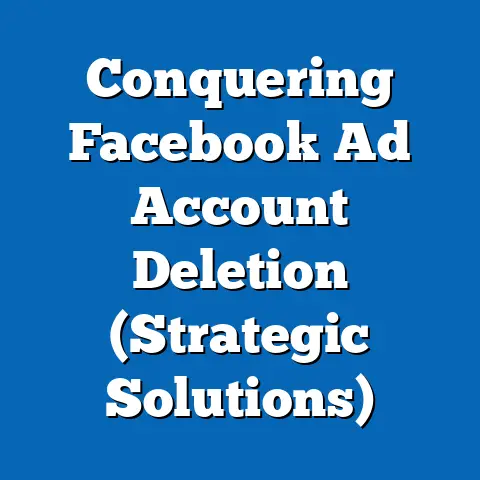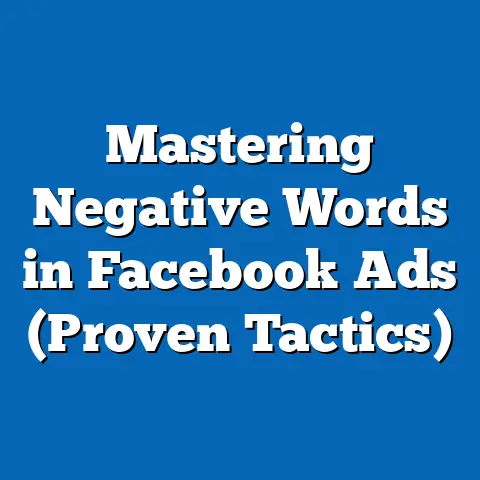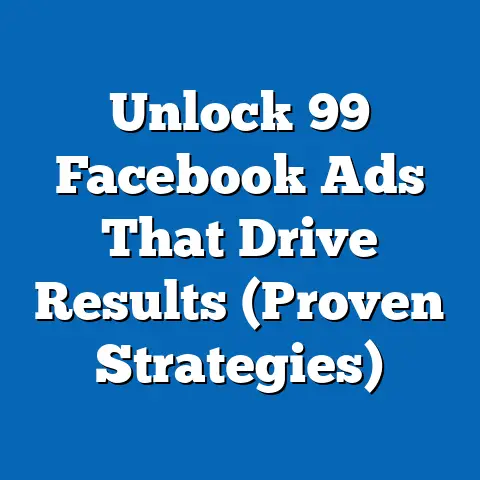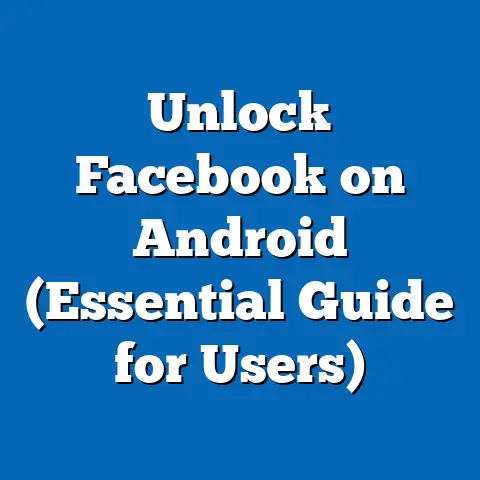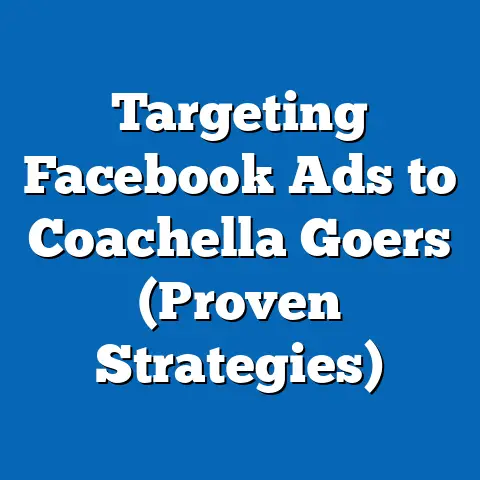Maximize Game Engagement with Facebook Ads (Pro Tips)
If you’re not leveraging Facebook Ads to boost your game engagement, you’re essentially throwing away your marketing budget and letting your competition win. It might sound harsh, but in today’s hyper-competitive gaming market, a strong Facebook Ads strategy isn’t optional, it’s essential. I’ve seen firsthand how a well-crafted campaign can transform a struggling indie title into a breakout success, and conversely, how even a brilliant game can flounder without effective marketing. The platform’s unparalleled reach and sophisticated targeting capabilities offer game developers a golden opportunity to connect with their ideal audience, build a loyal player base, and ultimately, drive downloads and in-app purchases. But with thousands of games vying for attention, simply running ads isn’t enough. You need to be strategic, creative, and data-driven to truly cut through the noise and make an impact. This guide provides the pro tips I’ve learned over years of running Facebook Ads for various gaming companies, helping you level up your strategy and maximize your game’s engagement.
Understanding Your Audience: The Foundation of a Winning Campaign
You can have the most visually stunning ads and the catchiest copy, but if you’re showing them to the wrong people, you’re wasting your money. That’s why understanding your audience is the absolute bedrock of any successful Facebook Ads campaign. In the gaming world, this is especially critical, as player preferences can vary wildly across genres, platforms, and even specific titles.
The Importance of Audience Segmentation in Gaming
Think about it: the audience for a hardcore MMORPG is vastly different from the audience for a casual puzzle game. Trying to reach both groups with the same generic ad is a recipe for disaster. Audience segmentation allows you to divide your potential players into smaller, more specific groups based on shared characteristics, interests, and behaviors. This enables you to tailor your ads to resonate with each segment, increasing engagement and conversions.
I remember working with a mobile RPG developer who was struggling to acquire new players. They were running broad-reach campaigns targeting anyone interested in “fantasy games.” After diving into their game analytics and conducting some audience research, we realized their core player base consisted of two distinct groups: “hardcore RPG fans” who loved deep storylines and complex mechanics, and “casual players” who enjoyed the game’s social features and character customization. By creating separate campaigns targeting each group with tailored messaging and visuals, we saw a dramatic increase in click-through rates and install rates.
Unlocking Demographic Insights with Facebook Insights
Facebook Insights is your treasure map to understanding your audience. This powerful tool provides a wealth of demographic data, including:
- Age and Gender: Essential for understanding the basic makeup of your player base.
- Location: Identify where your game is most popular and tailor your campaigns accordingly.
- Interests: Discover the other games, hobbies, and brands your audience is interested in.
- Behaviors: Understand how your audience interacts with Facebook and other platforms.
To access Facebook Insights, you’ll need to have a Facebook Page for your game. Once you have a page, you can access the insights tab to see a detailed breakdown of your audience demographics.
Mastering Custom Audiences and Lookalike Audiences
While demographic targeting is a great starting point, Custom Audiences and Lookalike Audiences take your targeting to the next level.
- Custom Audiences: Allow you to target specific groups of people based on data you already have, such as:
- Email Lists: Upload your existing email list to target players who have already expressed interest in your game.
- Website Visitors: Retarget users who have visited your game’s website but haven’t yet downloaded it.
- App Users: Target players who have already installed your game and encourage them to make in-app purchases or invite friends.
- Lookalike Audiences: Allow you to expand your reach by targeting new users who share similar characteristics with your existing customers. This is a powerful way to find high-potential players who are likely to enjoy your game.
- Email Lists: Upload your existing email list to target players who have already expressed interest in your game.
- Website Visitors: Retarget users who have visited your game’s website but haven’t yet downloaded it.
- App Users: Target players who have already installed your game and encourage them to make in-app purchases or invite friends.
For example, if you have a Custom Audience of players who have spent money in your game, you can create a Lookalike Audience based on that group. Facebook will then identify other users who share similar demographics, interests, and behaviors as your paying players, giving you a highly targeted pool of potential customers.
Examples of Successful Audience Targeting Strategies
Here are a few examples of how successful games have used audience targeting to achieve their marketing goals:
- Mobile Legends: Bang Bang: This popular MOBA game uses Custom Audiences to retarget players who have abandoned their shopping carts in the in-game store. By showing these players ads featuring the items they almost purchased, they encourage them to complete the transaction.
- Clash of Clans: This strategy game uses Lookalike Audiences to find new players who are similar to their most engaged and valuable users. They then target these users with ads showcasing the game’s strategic gameplay and social features.
- Genshin Impact: This open-world RPG uses interest-based targeting to reach players who are interested in anime, RPGs, and other similar games. They then showcase the game’s stunning visuals and immersive storyline in their ads.
Takeaway: Never underestimate the power of knowing your audience. Use Facebook Insights, Custom Audiences, and Lookalike Audiences to create highly targeted campaigns that resonate with your ideal players.
Crafting Compelling Ad Creatives: Stop the Scroll!
In the fast-paced world of social media, you have mere seconds to capture a user’s attention. That’s why crafting compelling ad creatives is absolutely crucial. Your ads need to be visually appealing, engaging, and relevant to your target audience. Think of your ad creative as the bait that lures players into your game.
Eye-Catching Visuals and Engaging Copy: A Winning Combination
The first thing people see is your ad’s visual. It needs to be attention-grabbing, high-quality, and representative of your game’s unique style. This could be a stunning screenshot of gameplay, a captivating character illustration, or a dynamic video showcasing the game’s most exciting features.
But visuals alone aren’t enough. Your ad copy needs to be equally compelling. It should be concise, engaging, and clearly communicate the value proposition of your game. What makes your game unique? What are the key features that will appeal to your target audience?
I’ve found that using strong action verbs, asking engaging questions, and creating a sense of urgency can significantly improve ad performance. For example, instead of saying “Download our game,” try “Embark on an epic adventure today!” or “Join millions of players and conquer the realm!”
Guidelines for Creating Ad Creatives That Resonate with Gamers
Here are some specific guidelines for creating ad creatives that resonate with gamers:
- Use High-Quality Images and Videos: Blurry or pixelated visuals will instantly turn off potential players. Invest in high-quality assets that showcase your game in the best possible light.
- Showcase Gameplay: Gamers want to see what your game is actually like. Include short clips of exciting gameplay in your video ads.
- Highlight Key Features: Focus on the features that make your game unique and appealing. Is it the deep storyline? The strategic gameplay? The stunning visuals?
- Use a Strong Call to Action: Tell users exactly what you want them to do. “Download Now,” “Play for Free,” or “Join the Adventure” are all effective calls to action.
- Tailor Your Creatives to Your Target Audience: Remember, what appeals to one group of gamers may not appeal to another. Tailor your visuals and copy to resonate with each specific audience segment.
The Power of Storytelling in Ads
Gamers are passionate about stories. They love to immerse themselves in rich narratives, compelling characters, and epic worlds. Incorporating storytelling into your ads can be a powerful way to connect with your target audience on an emotional level.
For example, instead of simply showcasing gameplay, you could create a short video that tells the story of a key character in your game. Or you could use your ad copy to tease a compelling plot point or mystery.
Examples of Successful Ad Creatives
Here are a few examples of successful ad creatives that effectively capture attention:
- Raid: Shadow Legends: This game uses stunning character illustrations and epic battle scenes in its ads to create a sense of excitement and adventure.
- PUBG Mobile: This game uses dynamic gameplay footage and competitive scenarios in its ads to showcase the thrill of the battle royale experience.
- Candy Crush Saga: This game uses bright, colorful visuals and catchy music in its ads to appeal to casual gamers looking for a fun and relaxing experience.
Takeaway: Your ad creatives are your first impression. Make them count! Use high-quality visuals, engaging copy, and storytelling to capture attention and entice players to download your game.
Utilizing Video Ads: Engage, Immerse, Convert
In the world of Facebook advertising, video is king. It’s the most engaging and versatile ad format, allowing you to showcase your game in a dynamic and immersive way. Video ads can be used to capture attention, tell a story, highlight key features, and ultimately, drive downloads and in-app purchases.
The Power of Video Content
Video content simply outperforms static images and text when it comes to capturing attention and driving engagement. People are more likely to watch a video than read a long block of text, and videos can convey more information in a shorter amount of time.
I’ve seen countless campaigns where switching from static image ads to video ads resulted in a significant increase in click-through rates and conversion rates. Video allows you to showcase the actual gameplay, the stunning visuals, and the overall experience of your game in a way that static images simply can’t.
Tips for Creating Impactful Video Ads
Here are some tips for creating short, impactful video ads that showcase gameplay and features:
- Keep it Short and Sweet: Aim for videos that are 15-30 seconds long. People have short attention spans, so you need to grab their attention quickly and keep them engaged.
- Start Strong: The first few seconds of your video are crucial. Use a captivating visual or a compelling hook to grab viewers’ attention.
- Showcase Gameplay: Gamers want to see what your game is actually like. Include short clips of exciting gameplay in your video ads.
- Highlight Key Features: Focus on the features that make your game unique and appealing.
- Use a Clear Call to Action: Tell viewers exactly what you want them to do. “Download Now,” “Play for Free,” or “Join the Adventure” are all effective calls to action.
- Use Captions: Many people watch videos with the sound off, so it’s important to include captions to ensure they can understand your message.
Optimal Video Lengths and Formats
Facebook recommends using video lengths that are 15 seconds or less for optimal performance. Shorter videos tend to have higher completion rates and lower costs per view.
As for formats, MP4 is the most widely supported video format on Facebook. Facebook also recommends using a 1:1 (square) or 9:16 (vertical) aspect ratio for your videos, as these formats tend to perform better on mobile devices.
Leveraging Facebook’s Video Ad Placements
Facebook offers a variety of video ad placements, including:
- Facebook Feed: Videos that appear in users’ news feeds.
- Instagram Feed: Videos that appear in users’ Instagram feeds.
- Facebook Stories: Short, vertical videos that appear in users’ Facebook Stories.
- Instagram Stories: Short, vertical videos that appear in users’ Instagram Stories.
- Facebook In-Stream Videos: Videos that play before, during, or after other videos on Facebook.
Experiment with different placements to see which ones perform best for your game.
Case Studies of Successful Video Ad Campaigns
Here are a few case studies of games that have successfully used video ads to boost engagement:
- Gardenscapes: This game uses heartwarming and humorous video ads to showcase the game’s engaging storyline and charming characters.
- Homescapes: This game uses similar video ad strategies to Gardenscapes, focusing on the game’s narrative and character development.
- Rise of Kingdoms: This strategy game uses epic and action-packed video ads to showcase the game’s strategic gameplay and historical setting.
Takeaway: Video ads are a powerful tool for engaging users and driving downloads. Create short, impactful videos that showcase gameplay, highlight key features, and use a clear call to action.
Leveraging Facebook Ad Formats: Beyond the Basic
Facebook offers a diverse range of ad formats beyond the standard image and video ads. Utilizing these different formats can help you showcase your game in creative and engaging ways, leading to higher click-through rates and conversions.
Exploring Different Ad Formats
Here are some of the most popular Facebook ad formats and how they can be used to promote your game:
- Carousel Ads: Allow you to showcase multiple images or videos in a single ad. This is a great way to highlight different features of your game, showcase multiple characters, or tell a story through a series of images.
- Slideshow Ads: Similar to video ads, but created using a series of static images. This is a cost-effective way to create engaging video-like content without the need for expensive video production.
- Collection Ads: Designed for mobile devices, these ads allow users to browse and purchase products directly from the ad. This is a great option for games that offer in-app purchases or virtual items.
- Instant Experience Ads (formerly Canvas Ads): Full-screen, mobile-optimized ads that provide an immersive and interactive experience. This is a great way to showcase your game’s world, characters, and gameplay in a highly engaging format.
- Playable Ads: Allow users to try a demo of your game directly from the ad. This is a highly effective way to drive downloads, as users can experience the game before committing to a download.
Advantages of Each Format
Each ad format offers unique advantages:
- Carousel Ads: Versatile, allows for showcasing multiple aspects of your game, and can drive traffic to different landing pages.
- Slideshow Ads: Cost-effective, easy to create, and can be used to tell a story or highlight key features.
- Collection Ads: Streamlined shopping experience, ideal for games with in-app purchases, and visually appealing.
- Instant Experience Ads: Immersive, interactive, and allows for showcasing your game’s world and characters in detail.
- Playable Ads: High conversion rates, allows users to try the game before downloading, and provides a direct path to download.
Examples of Using Different Formats
Here are some examples of how different ad formats can be used to showcase different aspects of a game:
- Carousel Ads: A mobile RPG could use a carousel ad to showcase different character classes, each with its unique abilities and playstyles.
- Slideshow Ads: A puzzle game could use a slideshow ad to demonstrate the game’s mechanics, show different levels, and highlight the game’s colorful visuals.
- Collection Ads: A strategy game could use a collection ad to showcase different in-app purchases, such as resources, units, or cosmetic items.
- Instant Experience Ads: An adventure game could use an Instant Experience ad to create an immersive tour of the game’s world, showcasing different locations, characters, and quests.
- Playable Ads: Any game can use a playable ad to allow users to try a demo of the game directly from the ad.
Takeaway: Don’t limit yourself to basic ad formats. Explore the different options available on Facebook and experiment with different formats to see which ones perform best for your game.
Retargeting Strategies: Re-Engage and Convert
Not everyone who sees your ad will download your game immediately. In fact, most people need to see your ad multiple times before they take action. That’s where retargeting comes in.
The Importance of Retargeting
Retargeting allows you to target players who have already shown interest in your game, but haven’t yet downloaded it or made an in-app purchase. This could include users who have visited your game’s website, watched your video ads, or interacted with your Facebook Page.
By targeting these users with tailored ads, you can remind them about your game, highlight its key features, and encourage them to take the next step.
Setting Up Retargeting Campaigns
To set up retargeting campaigns on Facebook, you’ll need to install the Facebook Pixel on your game’s website and/or integrate the Facebook SDK into your game. The Facebook Pixel is a small piece of code that tracks user activity on your website, while the Facebook SDK allows you to track user activity within your game.
Once you have the Pixel and SDK set up, you can create Custom Audiences based on specific user behaviors, such as:
- Website Visitors: Target users who have visited your game’s website but haven’t yet downloaded it.
- Video Viewers: Target users who have watched your video ads but haven’t yet downloaded your game.
- App Users: Target players who have already installed your game and encourage them to make in-app purchases or invite friends.
Best Practices for Retargeting Ads
Here are some best practices for crafting retargeting ads that convert interest into engagement:
- Tailor Your Messaging: Your retargeting ads should be different from your initial ads. Focus on reminding users about your game and highlighting its key features.
- Offer Incentives: Consider offering incentives, such as a discount or bonus, to encourage users to download your game or make an in-app purchase.
- Use a Sense of Urgency: Create a sense of urgency by using language like “Limited Time Offer” or “Download Now Before It’s Too Late.”
- Use Social Proof: Showcase positive reviews or testimonials to build trust and credibility.
Statistics and Case Examples
Retargeting is a highly effective advertising strategy. Studies have shown that retargeting ads have a significantly higher click-through rate than standard display ads.
I’ve seen firsthand how retargeting can dramatically improve game engagement. For example, I worked with a mobile strategy game that was struggling to convert website visitors into downloads. By setting up a retargeting campaign targeting website visitors with tailored ads highlighting the game’s strategic gameplay and social features, we saw a 50% increase in download conversions.
Takeaway: Retargeting is a powerful tool for re-engaging users who have already shown interest in your game. Use it to remind them about your game, highlight its key features, and encourage them to take the next step.
A/B Testing for Optimization: Always Be Testing
In the world of Facebook advertising, nothing is set in stone. What works today may not work tomorrow. That’s why A/B testing is so critical.
The Importance of A/B Testing
A/B testing, also known as split testing, allows you to compare two versions of an ad to see which one performs better. By testing different elements of your ads, such as headlines, visuals, and calls to action, you can identify what resonates best with your target audience and optimize your campaigns for maximum engagement.
I’ve seen countless campaigns transformed through systematic A/B testing. Even small changes, like a different headline or a slightly different image, can have a significant impact on ad performance.
Setting Up A/B Tests
Facebook makes it easy to set up A/B tests. You can create two versions of an ad and then use Facebook’s A/B testing tool to split your audience and show each version to a different group of users.
Analyzing the Results
Once your A/B test has run for a sufficient amount of time, you can analyze the results to see which version performed better. Facebook provides detailed metrics, such as click-through rate, conversion rate, and cost per conversion, to help you make data-driven decisions.
Success Stories
Here are some success stories of games that have improved their ad performance through systematic testing:
- A mobile puzzle game increased its click-through rate by 20% by testing different headlines in its ads.
- A strategy game increased its conversion rate by 15% by testing different visuals in its ads.
- An adventure game decreased its cost per conversion by 10% by testing different calls to action in its ads.
Takeaway: A/B testing is essential for optimizing your Facebook Ads campaigns. Use it to test different elements of your ads and identify what resonates best with your target audience.
Measuring Success and KPIs: Are You Winning?
Running Facebook Ads without tracking your results is like driving a car blindfolded. You need to know where you’re going and how well you’re performing in order to make informed decisions and optimize your campaigns.
Key Performance Indicators (KPIs)
Here are some key performance indicators (KPIs) that game developers should track to measure engagement:
- Click-Through Rate (CTR): The percentage of users who click on your ad after seeing it.
- Conversion Rate: The percentage of users who download your game or make an in-app purchase after clicking on your ad.
- Cost Per Click (CPC): The average cost you pay for each click on your ad.
- Cost Per Install (CPI): The average cost you pay for each download of your game.
- Return on Ad Spend (ROAS): The amount of revenue you generate for every dollar you spend on advertising.
- Retention Rate: The percentage of players who continue to play your game over time.
- Lifetime Value (LTV): The total amount of revenue you generate from each player over the course of their engagement with your game.
Tools and Methods for Tracking Ad Performance
Facebook Ads Manager provides a wealth of data on your ad performance. You can use this data to track your KPIs, identify trends, and make informed decisions about your campaigns.
You can also use third-party analytics tools, such as AppsFlyer or Adjust, to track your ad performance and gain deeper insights into your player behavior.
Interpreting Data
It’s important to not just track your KPIs, but also to interpret the data and understand what it means. For example, a high CTR may indicate that your ad creatives are engaging, but a low conversion rate may indicate that your landing page is not optimized.
By analyzing your data and understanding the relationship between different KPIs, you can identify areas for improvement and optimize your campaigns for maximum engagement.
Takeaway: Measuring your success is critical for optimizing your Facebook Ads campaigns. Track your KPIs, analyze your data, and make informed decisions to maximize engagement and ROI.
Conclusion: Engage or Be Forgotten
Facebook Ads offers an unparalleled opportunity for game developers to connect with their target audience, build a loyal player base, and drive downloads and in-app purchases. By understanding your audience, crafting compelling ad creatives, utilizing video ads, leveraging different ad formats, implementing retargeting strategies, A/B testing for optimization, and measuring your success, you can create highly effective Facebook Ads campaigns that level up your game engagement.
In the world of gaming, the difference between success and failure often lies in how well you engage your audience—are your Facebook Ads up to the challenge? I believe that with the right strategy and a commitment to continuous improvement, you can conquer the gaming market and achieve your marketing goals. So, dive in, experiment, and start engaging your players today!

